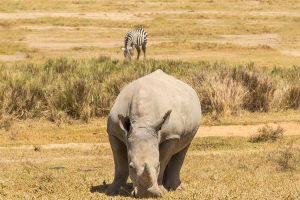The cheetah stands as one of nature's most extraordinary creatures, renowned for its unparalleled speed and agility.
As the fastest land animal on Earth, the cheetah's anatomy and behavior are intricately linked to its remarkable running capabilities.
Its elongated body and slender, powerful legs enable it to reach speeds exceeding 100 kilometers per hour in just seconds.
This exceptional velocity is not solely attributed to the cheetah's bone structure and flexible spine but also relies heavily on a robust cardiovascular system, including a strong heart and lungs that ensure a continuous supply of oxygen.
The cheetah's fur is a striking light yellowish-brown, adorned with irregular black spots scattered across its body. These spots not only contribute to the cheetah's distinctive appearance but also serve a practical purpose by aiding in camouflage within the grasslands.
Additionally, the black "tear marks" that extend from the corners of the cheetah's eyes to the corners of its mouth enhance its visual acuity. These markings reduce the glare of sunlight, thereby improving the cheetah's ability to see clearly at high speeds.
Cheetahs predominantly inhabit the open grasslands and savannas of Africa, environments that offer ample space for running and a suitable range of prey. However, the cheetah's habitat is increasingly threatened by human activities.
The destruction of their natural habitat and the decline in prey populations pose significant challenges to their survival. The cheetah's hunting strategy is equally fascinating.
It typically involves approaching its prey stealthily and then launching an explosive sprint when the distance is short, achieving the kill at an astonishing speed. Nevertheless, this high-speed chase quickly exhausts the cheetah, necessitating a longer recovery period post-hunt.
Moreover, cheetahs face additional threats beyond habitat loss. Conflicts with domestic animals also pose a risk, as cheetahs occasionally prey on livestock, leading to retaliatory killings by farmers.
To combat these challenges and ensure the survival of cheetahs, numerous organizations and institutions are actively involved in protective measures. These efforts include establishing and managing protected areas, conducting anti-poaching initiatives, and advancing ecological education.
The international community has also recognized the importance of cheetah conservation, engaging in collaborative efforts and scientific research to find effective solutions.
The cheetah, a marvel of nature, commands our admiration for its incredible speed and elegant hunting techniques. Nonetheless, the survival of this remarkable species is increasingly imperiled by environmental changes and intensified human activities.
It is crucial to secure the future of cheetahs by safeguarding their habitats, enhancing ecological education, and fostering international cooperation. Through these concerted efforts, we can ensure that this magnificent creature continues to grace our planet.


